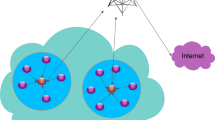Abstract
Recent technological advances and developments in the field of communication information systems, especially in microelectro mechanical systems have provided the ground for the production and setup of small nodes which are supplied with batteries with limited batteries. These nodes have wireless communications with each other. A WSN includes a large number of sensor nodes which are located densely or scatteredly within a phenomenon or with a little distance from it. However, it should be noted that sensor nodes have low computational capability, little storage space and limited battery power. Due to resource limitations, a compromise should be made between processing precision and power optimization in WSNs. In this paper, using LPO algorithm and fuzzy logic, we proposed a novel energy-aware clustering method which lightweight and has relatively high precision. In the proposed method, clustering is done according to two main parameters, i.e. node’s remaining energy and distance from the sink. The results of simulating the proposed method via OPNET 11.5 revealed that the proposed method contributed to the reduction of average delay, input packet, power consumption and enhanced network lifetime.





















Similar content being viewed by others
References
Shokouhifar, M., & Jalali, A. (2015). A new evolutionary based application specific routing protocol for clustered wireless sensor networks. AEU-International Journal of Electronics and Communications, 69(1), 432–441.
Villaverde, B. C., Rea, S., & Pesch, D. (2012). InRout–A QoS aware route selection algorithm for industrial wireless sensor networks. Ad Hoc Networks, 10(3), 458–478.
Chen, D. R. (2016). An energy-efficient QoS routing for wireless sensor networks using self-stabilizing algorithm. Ad Hoc Networks, 37, 240–255.
Moon, S. H., Park, S., & Han, S. J. (2017). Energy efficient data collection in sink-centric wireless sensor networks: A cluster-ring approach. Computer Communications, 101, 12–25.
Shokouhifar, M., & Jalali, A. (2015). A new evolutionary based application specific routing protocol for clustered wireless sensor networks. AEU-International Journal of Electronics and Communications, 69(1), 432–441.
Manickavasagam, V., & Padmanabhan, J. (2016). A mobility optimized SPRT based distributed security solution for replica node detection in mobile sensor networks. Ad Hoc Networks, 37, 140–152.
Chen, D. R. (2016). An energy-efficient QoS routing for wireless sensor networks using self-stabilizing algorithm. Ad Hoc Networks, 37, 240–255.
Cengiz, K., & Dag, T. (2018). Energy aware multi-hop routing protocol for WSNs. IEEE Access, 6, 2622–2633.
Zahedi, Z. M., Akbari, R., Shokouhifar, M., Safaei, F., & Jalali, A. (2016). Swarm intelligence based fuzzy routing protocol for clustered wireless sensor networks. Expert Systems with Applications, 55, 313–328.
Li, C., Bai, J., Gu, J., Yan, X., & Luo, Y. (2018). Clustering routing based on mixed integer programming for heterogeneous wireless sensor networks. Ad Hoc Networks, 72, 81–90.
Bozorgi, S. M., Rostami, A. S., Hosseinabadi, A. A. R., & Balas, V. E. (2017). A new clustering protocol for energy harvesting-wireless sensor networks. Computers & Electrical Engineering, 64, 233–247.
Wang, B., Jin, X., & Cheng, B. (2012). Lion pride optimizer: An optimization algorithm inspired by lion pride behavior. Science China Information Sciences, 55(10), 2369–2389.
Tabatabaei, S., & Omrani, M. R. (2018). Proposing a method for controlling congestion in wireless sensor networks using comparative fuzzy logic. Wireless Personal Communications, 100, 1–18.
Author information
Authors and Affiliations
Corresponding author
Additional information
Publisher's Note
Springer Nature remains neutral with regard to jurisdictional claims in published maps and institutional affiliations.
Rights and permissions
About this article
Cite this article
Tabatabaei, S., Rajaei, A. & Rigi, A.M. A Novel Energy-Aware Clustering Method via Lion Pride Optimizer Algorithm (LPO) and Fuzzy Logic in Wireless Sensor Networks (WSNs). Wireless Pers Commun 108, 1803–1825 (2019). https://doi.org/10.1007/s11277-019-06497-6
Published:
Issue Date:
DOI: https://doi.org/10.1007/s11277-019-06497-6




